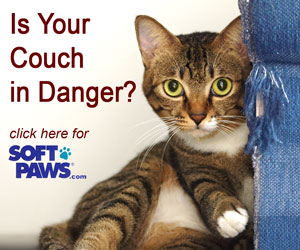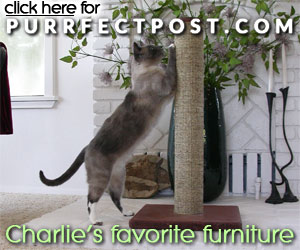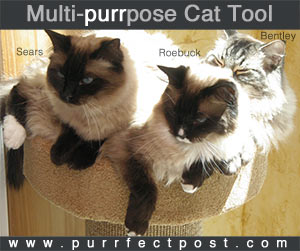How to Photograph Your Cat
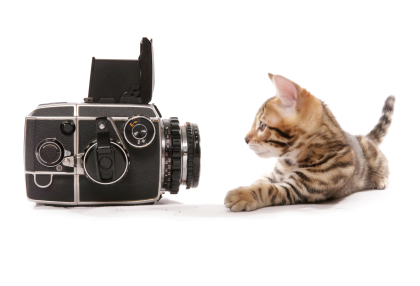 Note: This article assumes that:
Note: This article assumes that:
a) you're not a professional photographer
b) you have a digital camera.
Cats always look picture perfect. That doesn't mean that getting a good photo of them is easy. For example, your kitty might be sitting pretty, as if posing for the camera, but just as you're about to press the shutter, she gets up and walks away.
Here are some hints to help you capture your cat's radiant beauty and personality in a photograph, especially one suitable for a holiday greeting.
More Photos = Greater Chance of Success
Take lots of photos. You never know which ones are going to be keepers. Have your camera—and memory cards—handy so you can quickly take a few shots of your kitty when the moment is right. This gives you the freedom to experiment with different angles, lighting, camera settings, and props, thus maximizing your chances of ending up with photos you like.
Techniques to Improve Your Photos
Take photos at pet level. Often, this means getting down on your hands and knees or lower to get a cat's-eye view of your kitty. An alternative approach is to situate the cat on a perch or wait until she relocates there on her own. The idea is to avoid too many overhead shots of the kitty.
Get in close. You want the viewer not only to see the delicate shades of the kitty's coat, but also to get a feel for her majestic presence (or demure cuteness) and practically hear her purr. If the background on the close-up is out of focus, that can make the photo look even better – imagine a close-up of a kitty with a hint of holly in the background. A zoom lens is your friend, enabling you to achieve the close-in effect without approaching the cat and causing her to move.
Fill the frame with your feline subject. You don't want a panorama of the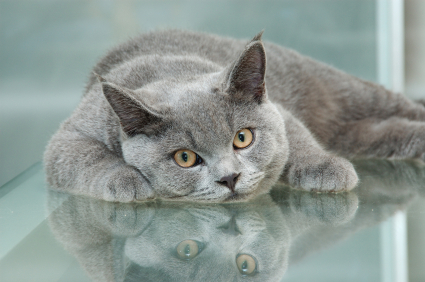 living room with a cat in the corner. The attention—as would seem proper—should be on the feline of the house. If the kitty is part of a group picture, then of course the group should fill the frame. The main exception to this rule is when you have a prop that is essential to the story; for example, a tall scratching post on which the kitty is getting a satisfying workout. But even then, it may be more interesting to zoom in on the kitty's determined face and paws as she joyfully shreds. If you do get a good shot of your cat but it contains lots of extraneous clutter, you can always crop the photo.
living room with a cat in the corner. The attention—as would seem proper—should be on the feline of the house. If the kitty is part of a group picture, then of course the group should fill the frame. The main exception to this rule is when you have a prop that is essential to the story; for example, a tall scratching post on which the kitty is getting a satisfying workout. But even then, it may be more interesting to zoom in on the kitty's determined face and paws as she joyfully shreds. If you do get a good shot of your cat but it contains lots of extraneous clutter, you can always crop the photo.
The eyes have it. With very few exceptions, ensure that the kitty’s eyes are prominent in the picture, even if they’re closed.
Favor natural light. The sunbeam bathing your cat's face brings out the true, rich hues of her fur, whiskers, and eyes. With flash, you have to contend with shadows and red eyes. If using flash is unavoidable because you’re restricted to taking pictures at night or in low light conditions, one option is to purchase a bounce flash, so the light reflects off the ceiling instead of your subject's eyes and face.
Keep the background simple. You don't want viewers to be distracted by the modern art picture hanging just above the kitty's head. When possible, look for a setting that won’t have distractions behind or next to the main star. You can also temporarily remove or cover objects that will detract from the photos.
Try for a contrasting background. It's difficult to see a black cat against a black background, much less make out her expressiveness and graceful contours. The general rule is: light cats against a dark background, dark cats against a light background. If someone will be holding the kitty in the picture, this could affect his or her choice of clothing. Remember to offer a lint brush afterward.
We Are Family
A photo of a kitty with her people shows togetherness. Your cat's part of the family, and including her in the family portrait reflects her special status and the close bond between the kitty and her humans. Be sure to add a pawprint signature to the card. Hint: When taking the group picture, it may be much easier to move the humans to the kitty’s preferred spot than the other way around.
Sleepy, Alert, Playful, Boisterous . . . So Many Moods from Which to Choose
Pictures of totally relaxed cats exude peace and calmness. After a play session and hearty meal, your cat may wash up, pick out a comfy spot, and gradually settle into a nap. These tranquil pre-nap periods are ideal for taking dreamy pictures of your cat. If your cat enjoys being held and you have a helper, you may get some great photos of your blissful kitty while she’s getting some loving and purring away.
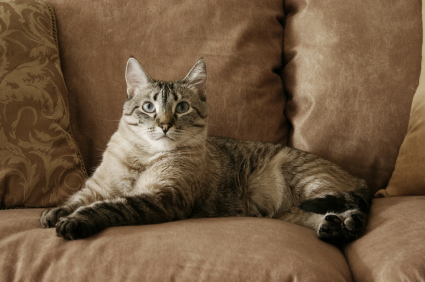 A portrait is classic. An excellent time to take your cat’s portrait is when she’s on a favorite perch, watching the birds and wildlife outside. Possibly with the help of an assistant, redirect her interest by making a wand toy fly through the air; the kitty may intently follow the object with her eyes and face, providing you with interesting expressions and postures. Talking and singing to your cat may inspire her to look quizzically at you—more good photo opportunities.
A portrait is classic. An excellent time to take your cat’s portrait is when she’s on a favorite perch, watching the birds and wildlife outside. Possibly with the help of an assistant, redirect her interest by making a wand toy fly through the air; the kitty may intently follow the object with her eyes and face, providing you with interesting expressions and postures. Talking and singing to your cat may inspire her to look quizzically at you—more good photo opportunities.
An action shot can be exciting and a little different. Enlist an assistant to engage in gentle play with your kitty and you may get some wonderful shots; pictures of a feisty and happy feline playfully batting a catnip-filled curiosity are sure to generate smiles. If you're up for the challenge, photos of cats in the middle of a leap or a pounce can be fascinating and convey their athleticism and unabashed enthusiasm when playing. You may have to manually adjust your camera's shutter speed and other settings to end up with a sharp photo instead of a blur, although many cameras have a selectable option for taking pictures of fast-moving subjects.
You May Also Like These Articles:
How to Use Clicker Training to Keep Your Cat off the Counter
Common Cat Behavior Problems and How to Solve Them: Slideshow
Cat Costumes: Purr-ific or Cat-astrophe?
How to Tell Cats You Love Them
Ways Your Cat Shows You Love: Slideshow
Notice: Ask-a-Vet is an affiliated service for those who wish to speak with a veterinary professional about their pet's specific condition. Initially, a bot will ask questions to determine the general nature of your concern. Then, you will be transferred to a human. There is a charge for the service if you choose to connect to a veterinarian. Ask-a-Vet is not manned by the staff or owners of CatHealth.com, and the advice given should not delay or replace a visit to your veterinarian.


